 Despite the fact that the first ground-based scanners appeared back in the last century, one can hardly say that a 3D-scanning laser technology is widely used in the design and construction of industrial facilities. The main reasons are probably the cost of such systems which is still high and the lack of information about how to use them effectively in particular applications. Nevertheless, interest in this technology and demand for it on the market of surveying equipment is growing in geometric progression with every year, and the high cost of the acquisition is more and more compensated by the offers from scanning services providers.
Despite the fact that the first ground-based scanners appeared back in the last century, one can hardly say that a 3D-scanning laser technology is widely used in the design and construction of industrial facilities. The main reasons are probably the cost of such systems which is still high and the lack of information about how to use them effectively in particular applications. Nevertheless, interest in this technology and demand for it on the market of surveying equipment is growing in geometric progression with every year, and the high cost of the acquisition is more and more compensated by the offers from scanning services providers.
Depending on the project goals and objectives, the laser scanning technology can be effectively combined with 3D-design technologies.
Recently designers of technologically complex industrial facilities have more and more invoked intellectual 3D-design. Due to the highly detailed elaboration, a 3D-model contains fairly large amount of information on the shape and parameters of process equipment, as well as all the necessary engineering and technical information for the formation and release of DED and subsequent needs for procurement, supply, construction and operation. As a consequence, now designers ordering measurement works want to get not only executive geodetic schemes with imprinted design values and the actual dimensions of individual components, but also detailed data in a three-dimensional representation, containing the volume of information comparable with a design digital model in terms of detailed elaboration. The software plays a very important role in quick and efficient processing of point clouds, obtained through high resolution laser shooting.
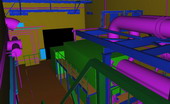 In modern practice, in most cases the Customer (an operating organization ordering the whole range of activities, from feasibility study to start-up and commissioning) faces a situation in which a three-dimensional model of operation has significant differences with what has been actually built on site. Presently, there are proven solutions allowing to quickly and efficiently get a so-called executive model of the plant or other complex engineering object. The other common problem of design organizations is the need for deep modernization and reconstruction of existing engineering structures and enterprises of continuous operation. Existing technologies allow to automate routine tasks and improve the speed and quality of diverse reconstruction works “from hard copy”, that is, using documentation available in the archives, or, in the absence of such, the integrated informational executive model of the enterprise or its individual parts, depending on the tasks at hand.
In modern practice, in most cases the Customer (an operating organization ordering the whole range of activities, from feasibility study to start-up and commissioning) faces a situation in which a three-dimensional model of operation has significant differences with what has been actually built on site. Presently, there are proven solutions allowing to quickly and efficiently get a so-called executive model of the plant or other complex engineering object. The other common problem of design organizations is the need for deep modernization and reconstruction of existing engineering structures and enterprises of continuous operation. Existing technologies allow to automate routine tasks and improve the speed and quality of diverse reconstruction works “from hard copy”, that is, using documentation available in the archives, or, in the absence of such, the integrated informational executive model of the enterprise or its individual parts, depending on the tasks at hand.
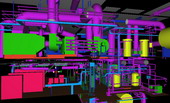 Let’s refer to the description of the informational model restoration. Intergraph, the developer of the software for the lifecycle management of an industrial facility, recommends to use Smart 3D three-dimensional design module together with Leica Geosystems software solutions, which allows to get a tool for intellectual 3D-model recovery from a point cloud.
Let’s refer to the description of the informational model restoration. Intergraph, the developer of the software for the lifecycle management of an industrial facility, recommends to use Smart 3D three-dimensional design module together with Leica Geosystems software solutions, which allows to get a tool for intellectual 3D-model recovery from a point cloud.
Leica CloudWorx solution stands as a software module for Smart3D embedded in a powerful Intergraph Smart3D shell. This module is designed for working with a point cloud, that is, for getting access to the database, where the point cloud is stored, further processing of the point cloud, and working with it inside Smart3D as a “substrate” for the purpose of accurate and error-free positioning of objects, measurement and design. Based on the proven Leica Cyclone technology, this program allows to use all Intergraph Smart3D tools for measurement, data correction, visualization of scanned pipeline structure components, model construction, based on Smart3D objects directory, and reporting.
Basically the laser scanning technology is as follows. First, a work plan is made, then a laser scanning procedure with panoramic photos of the facility is done. The rest of the work on the facility is remote. Scanning results go through primary processing, then a point cloud (the virtual copy of a real facility with one-millimeter-precise details) is obtained. It is often when a geometric modeling is performed, in order to create a vector model from the point cloud. The result of this stage is a geometric solid facility model available for import virtually to any CAD system. Typically, the geometric model is used for the reconstruction of industrial enterprises. It is important for a designer to know where and how the existing equipment and communication lines are located, as well as what are the geometric parameters of the area. The use of a three-dimensional model, made according to the scanning data, at the design stage of the reconstruction can significantly reduce the likelihood of collisions and errors at the construction stage and during the installation works. In the frames of the project described below another task was solved, namely, the comparison of the two models, as-designed and as-built. Such a comparison performed periodically during the construction of an industrial facility allows one to control the quality of construction and installation works, improve the efficiency of construction management processes, which, as a result, significantly reduces the likelihood of the delay in the construction schedule and exceeding of an estimated cost.
Another important task is to manage engineering data. This problem becomes more and more relevant with the increase in the complexity of facilities, model detailed elaboration, as well as the quantity and ways of presenting engineering information. For efficient operation it is necessary to use a tool that could “unite” all data into the information model (“as-built”), which will subsequently be used to manage complex engineering facility or project. Unfortunately, very often the potential of information modeling is underestimated by operating organizations. Taking into account the limited resources of engineering, administrative and IT personnel at the commissioned facilities, the task of data collection and tracking of changes to form the updated information model is extremely challenging, especially given the constant updates, conversions, overhauls and operational configuration changes of the enterprise.
New capital construction projects are also facing the problem related to the processing of large volumes of unstructured information, which is regularly obtained from suppliers, equipment manufacturers and project offices. If this information is not handled properly directly during the process of transfer from the contractor to the customer, it may be distorted or lost forever.
If we talk about “data collection” tool, it is crucial to find one that would allow us to organize data in order to make optimal management decisions. This approach allows to perform navigation with high degree of accuracy, while displaying real connections between design positions and forming an intelligent model of process facility.
The implementation of the above-described laser scanning technology, creating a point cloud and geometric information model allows to fully understand the peculiarities of solving the existing problem of facility information model recovery.
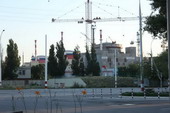 We need to refer to the example of project, illustrating the use of the technology described above. In 2013 a team of experts, which included representatives from Intergraph (Intergraph PP&M Russia, Moscow), Trimetari Consulting LLC (St. Petersburg), and Navgeokom (Moscow), has implemented a project to obtain three-dimensional information model for engineering facility (Rostov NPP 3 power unit backup diesel engine power plant) based on laser scanning technology. A leading design institute in the State Corporation structure of Rosatom – OJSC “NIAEP” – CJSC “Atomstroyexport” was the customer. The main objective of the works was to check the effectiveness of laser scanning and Intergraph technologies as a method of “as built” model construction in the reconstruction of existing facilities, in designing new facilities on the basis of the already existing ones in order to replicate the design solution, at the maintenance stage, etc. It should be noted that the authors are not aware of any cases as to the implementation of similar projects in Russia, although foreign design and operating organizations have long been using laser scanning capabilities and Intergraph CAD system to successfully perform these tasks. In particular, INPEX successfully used the above technology for Ichthys LNG project in Australia.
We need to refer to the example of project, illustrating the use of the technology described above. In 2013 a team of experts, which included representatives from Intergraph (Intergraph PP&M Russia, Moscow), Trimetari Consulting LLC (St. Petersburg), and Navgeokom (Moscow), has implemented a project to obtain three-dimensional information model for engineering facility (Rostov NPP 3 power unit backup diesel engine power plant) based on laser scanning technology. A leading design institute in the State Corporation structure of Rosatom – OJSC “NIAEP” – CJSC “Atomstroyexport” was the customer. The main objective of the works was to check the effectiveness of laser scanning and Intergraph technologies as a method of “as built” model construction in the reconstruction of existing facilities, in designing new facilities on the basis of the already existing ones in order to replicate the design solution, at the maintenance stage, etc. It should be noted that the authors are not aware of any cases as to the implementation of similar projects in Russia, although foreign design and operating organizations have long been using laser scanning capabilities and Intergraph CAD system to successfully perform these tasks. In particular, INPEX successfully used the above technology for Ichthys LNG project in Australia.
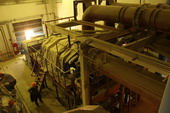 The facility was Rostov NPP, one of the largest energy companies in southern Russia (Figure 2). Power unit No. 1 is at the stage of pilot operation at power level of 104% from the rated capacity, power unit No. 2 was put into operation in 2010. Now, power units No. 3 and No. 4 are being built. Their commissioning is scheduled for 2014 and 2017, respectively. Electricity generation is over 25 million kWh per day and nearly 8 billion kWh per year.
The facility was Rostov NPP, one of the largest energy companies in southern Russia (Figure 2). Power unit No. 1 is at the stage of pilot operation at power level of 104% from the rated capacity, power unit No. 2 was put into operation in 2010. Now, power units No. 3 and No. 4 are being built. Their commissioning is scheduled for 2014 and 2017, respectively. Electricity generation is over 25 million kWh per day and nearly 8 billion kWh per year.
Laser scanning works were performed on stand-by diesel power plant for power unit No. 3. This building has 3 levels located at elevations ranging from -7 m to +9.6 m.
When scheduling the works, the following list of stages was approved:
- analysis of the design documentation obtained from “NIAEP” experts,
- field works at the facility – laser scanning,
- initial processing of laser scanning field data – registration and geo-referencing of scans,
- creation of spherical panorama service,
- construction of geometric (non-intellectual) model,
- obtaining a three-dimensional intellectual model for a process facility (see. Figure 9)
- Preparation of server grouping for the project
- Server preparation
- Software deployment and configuration
- Preparation of catalogues for modeling
- Expanding the obtained project catalogs to be further used at the stage of three-dimensional modeling
- Direct 3D modeling of the third cell in BDEPS building
- Comparison of modeling results with the available geometric model.
- Preparation of server grouping for the project
- processing the transmitted documentation set, structuring and loading the data into the Intergraph SmartPlant Fusion system,
- creating a single integration platform based on Intergraph SmartPlant Foundation.
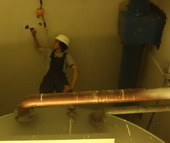 The latest model of Leica Geosystems, a Swiss manufacturer of surveying equipment, Scanner ScanStation P20 was used to perform laser scanning field works. The device has excellent specifications for shooting complex industrial facilities – maximum shooting range of 120 m, with 18% reflectivity, distance-determining accuracy of less than 1 mm, speed up to 1 million points per second, and built-in camera. In addition, the need to continue with the project by shooting the facility from the outside during cold season predetermined special requirements to scanning system “endurance”. Properties of P20 scanner (operating temperature from -20°C up to + 50°C and ingress protection IP54) allow using the device in harsh environments.
The latest model of Leica Geosystems, a Swiss manufacturer of surveying equipment, Scanner ScanStation P20 was used to perform laser scanning field works. The device has excellent specifications for shooting complex industrial facilities – maximum shooting range of 120 m, with 18% reflectivity, distance-determining accuracy of less than 1 mm, speed up to 1 million points per second, and built-in camera. In addition, the need to continue with the project by shooting the facility from the outside during cold season predetermined special requirements to scanning system “endurance”. Properties of P20 scanner (operating temperature from -20°C up to + 50°C and ingress protection IP54) allow using the device in harsh environments.
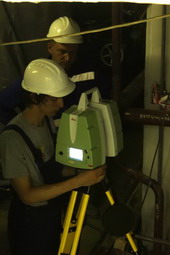 Initially, a plan of scanning works was worked out at the facility, registration method was selected, places of scanner installation were determined. Laser scanning was directly performed in the 360-degree mode with panoramic object capturing. During the two days of field works, shooting from 38 stations was carried out. Scanning performance was complicated by the concurrent construction and installation works at the facility. The advantages of the method (no touch and high shooting speed) minimize the impact of laser scanning works on construction or operating processes at industrial facilities.
Initially, a plan of scanning works was worked out at the facility, registration method was selected, places of scanner installation were determined. Laser scanning was directly performed in the 360-degree mode with panoramic object capturing. During the two days of field works, shooting from 38 stations was carried out. Scanning performance was complicated by the concurrent construction and installation works at the facility. The advantages of the method (no touch and high shooting speed) minimize the impact of laser scanning works on construction or operating processes at industrial facilities.
All subsequent works were remote and carried out in the office. Initial processing of laser scanning data – scan registration (merging into a single coordinate system) was performed during one day. Result of registration – point cloud – is a virtual copy of a real facility with a millimeter amount of detail (see. Figures 1, 8). The total number of points in the final cloud was 1.3 billion.
Geometric modeling was performed in Leica Cyclone software.  It took 23 man-days to create the vector model of the point cloud. Despite the fact that Leica Cyclone has broad capabilities for automatic entering of graphics primitives into a point cloud, modeling is made manually and mostly it is very laborious.
It took 23 man-days to create the vector model of the point cloud. Despite the fact that Leica Cyclone has broad capabilities for automatic entering of graphics primitives into a point cloud, modeling is made manually and mostly it is very laborious.
To load the point clouds and their subsequent processing in Smart3D, the following software was used:
• Leica Cyclone;
• Leica CloudWorx for Smart3D;
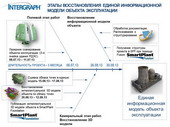 File was loaded to the same working project, based on which the facility was constructed, which provided the opportunity to combine the design model and the actual data (as built). Then, the facility was divided into sections according to layout civil axis, after that we made the FGA of these sites by identifying and recording the discrepancies. Therefore, as a result of this work, we received a list of actual discrepancies supported by visual materials. This allowed to promptly eliminate the detected discrepancies as early as on construction stage, to significantly improve the quality of the final facility, ultimately achieving full compliance with working documentation.
File was loaded to the same working project, based on which the facility was constructed, which provided the opportunity to combine the design model and the actual data (as built). Then, the facility was divided into sections according to layout civil axis, after that we made the FGA of these sites by identifying and recording the discrepancies. Therefore, as a result of this work, we received a list of actual discrepancies supported by visual materials. This allowed to promptly eliminate the detected discrepancies as early as on construction stage, to significantly improve the quality of the final facility, ultimately achieving full compliance with working documentation.
The emerging opportunities can hardly be underestimated:
1. Automatic model building by point cloud
2. Automatic determination of model intersection with point cloud, for example, if the model has been built without regard to the object point cloud location.
3. Elaboration of new (non-existent) structure without building the rest of the model.
With Cyclone or CloudWorx, one can organize group data processing. Cyclone works as a client-server application, so one can establish simultaneous access from several computers to a single database. Thus, all changes made in one computer will be immediately visible to others. Such feature significantly accelerates the processing of large data volumes.
 The resulting three-dimensional object model and high resolution panoramic images obtained by laser scanning were published in the SmartPlant Foundation, a portal integration kernel for complex design, solutions for information flow control by Intergraph company.
The resulting three-dimensional object model and high resolution panoramic images obtained by laser scanning were published in the SmartPlant Foundation, a portal integration kernel for complex design, solutions for information flow control by Intergraph company.
In addition, as part of the works on the pilot project OJSC “NIAEP”, experts have transferred about 600 MB of unstructured documents for 7 sections of the project in different formats. Most of the documentation was in scanned form. The scanned documentation was processed with the help of ABBYY software, and xml files with intelligent data and source documents were loaded into SmartPlant Fusion. Documents in dwg, doc, xls and other formats were processed using SmartPlant Fusion built-in tools, preliminary recognition with ABBYY was not required. In SmartPlant Fusion, the automatically loaded documentation was structured by sections of the project according to pre-configured rules. Design position classification by relevant standards was also configured.
SmartPlant Fusion “knows how” to handle different data sources to extract data in accordance with the defined rules, and to restore the consolidated information model based on this data. A variety of approaches to obtain data were used in the project. Information can be obtained from the stamp of the document (for example, document type, and description from the document stamp), from the file name (for example, in this project it was the archived document number), from the folder structure of the transmitted set of documentation (in the project the documents were classified based on the folder structure). The system allows extracting the information on the equipment and documentation related to it, building relationships and navigating among these objects. For example, by selecting the desired project position (pump, valve, etc.), it is possible to see all documents in the system associated with it, such as flow chart, wiring diagram, specifications, etc. Navigation mechanism allows moving from project position to photorealistic panoramic image obtained as a result of laser scanning and loaded into the system, and allows to see how equipment is installed on site. This functional feature helps to compare the actual state of the facility with the way it is displayed in the engineering documentation.
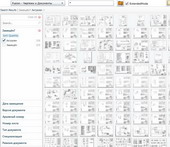 Remote and mobile access to ensure proper work is done via Web-portal SPF or Dashboard toolbar.
Remote and mobile access to ensure proper work is done via Web-portal SPF or Dashboard toolbar.
While demonstrating the results of the pilot project to the experts of OJSC “NIAEP” – CJSC “Atomstroyexport”, as well as representatives of other organizations, they emphasized the viability of laser scanning technology and SmartPlant Fusion solution. This technology can be successfully applied for the restoration of the documentation information model, reconstruction of existing facilities, design of new facilities on the basis of the already existing ones, at the commissioning stage, during operation, for decommissioning, and for the purpose of extending the service life of the facility.
“NIAEP-ASE recognizes the effectiveness of Intergraph solutions for information management. This helps to ensure safety in operation and reduce the project cost. We are very proud of the results that we have achieved together”, – said Gerhard Sallinger, president of Intergraph Process, Power&Marine.
Authors:
- Mikhail Anikushkin, CEO of Trimetari Consulting LLC, St. Petersburg, Russia
- Yevgenyi Beletskyi, Head of Technical Support Department, “Intergraph PPandM”, LLC, Moscow, Russia
- Yevgeniya Okunkova, Project Manager, “Intergraph PPandM”, LLC, Moscow, Russia
- Svyatoslav Serkov, Product Manager on Laser Scanners, “Navgeokom”, LLC, Moscow, Russia
- Sergey Smirnov, Senior Engineer, “Intergraph PPandM”, LLC, St. Petersburg, Russia
